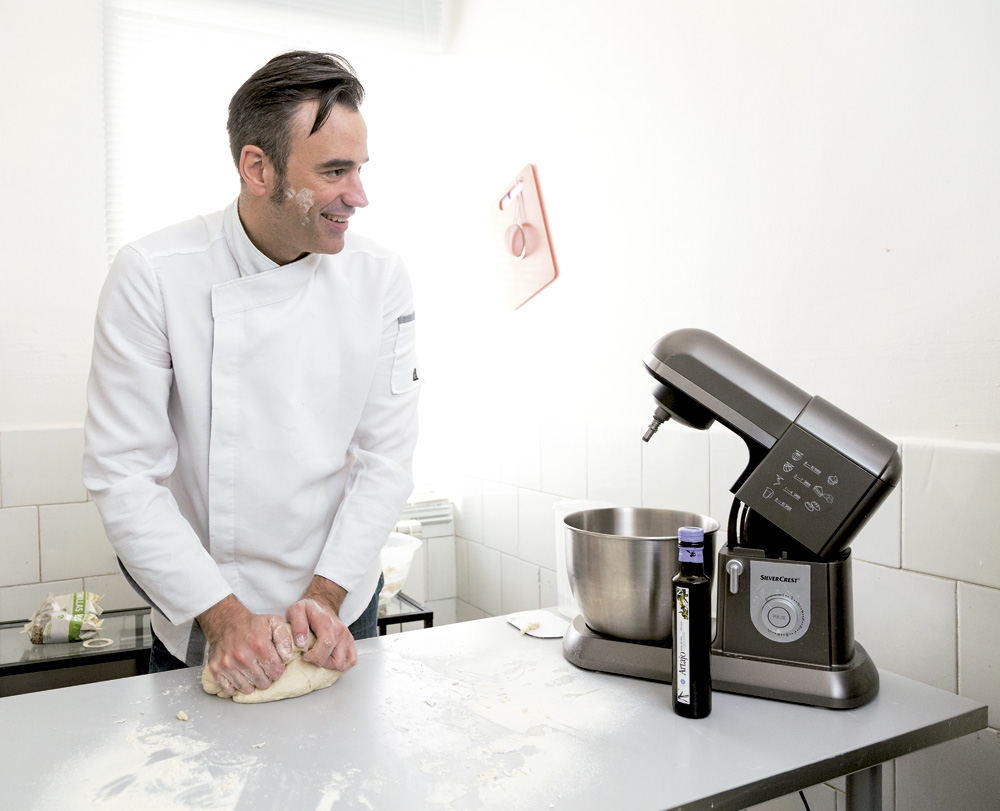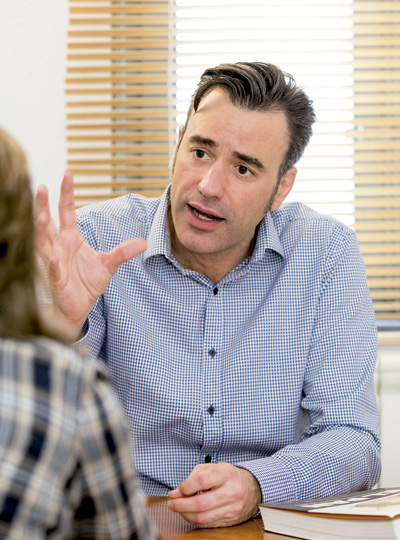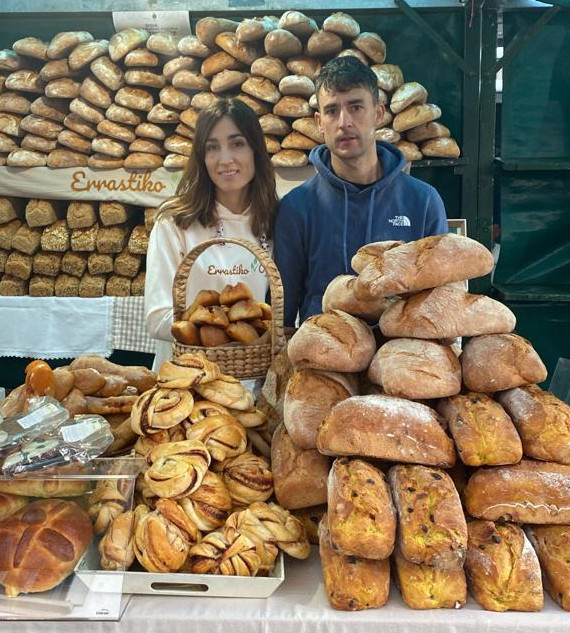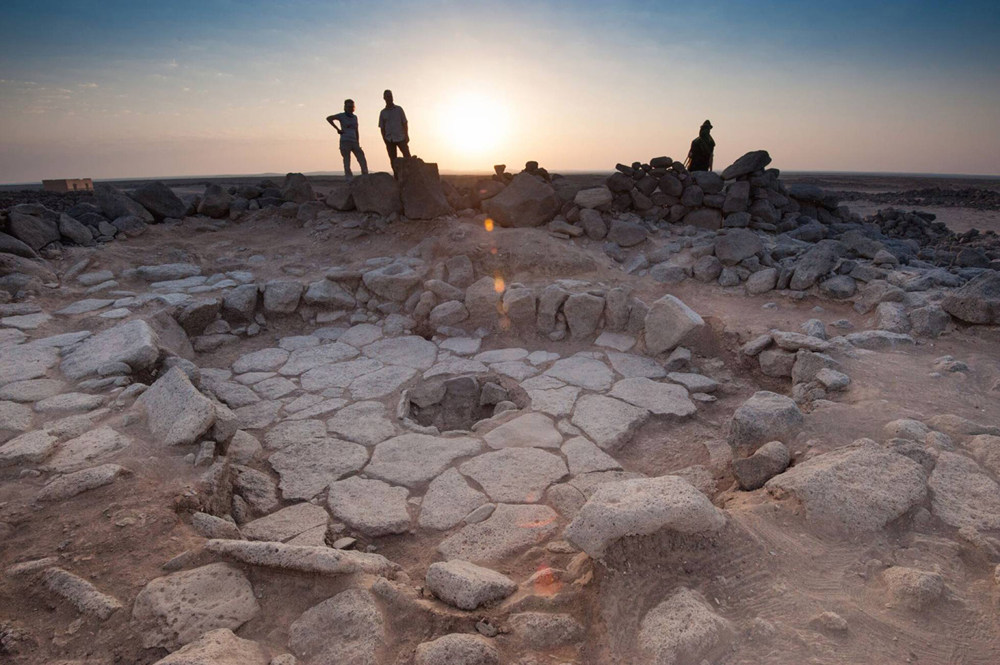"We should create a designation of origin for whole foods"
- Edorta Salvador is a baker who works in the diffusion of the advantages of mother dough bread and integral bread. He's an innovative craftsman who wants to discredit the bread and return the flavors that he had before industrialization.

Nekazaritza Ingeniaritza NUPen eta Elikagaien Zientzia eta Teknologia ikasketak egin zituen EHUn. Londresen ogi artisauaren arrakasta ezagutu eta hona ekarri zuen. Iruñean Pan Baker akademia zabaldu zuen duela hiru urte. Ikastaroak ematen ditu gaztelaniaz eta euskaraz Euskal Herri osoan, baita Espainiako Estatuan ere. Ogia egiten duten enpresa txiki eta ertainentzako aholkularitza zerbitzuak eskaintzen ditu. Basque Culinary Center-eko irakaslea da.
Where does the hobby for cooking come from?
From a young age. As my mother says, she ate everything. I liked everything and enjoyed it very much. The mother has always been a very good cook. Here we have excellent raw materials, great flavor, and that's why our traditional cooking is very rich without having to use a lot of spices or additives.
He has worked in several large food companies. What experiences have there been?
At the end of my career, I started working in a canning factory in the Ribera performing microbiological, physico-chemical analyses, etc. to tomatoes. From there I went to Panasa, the largest bakery company in Navarre. There I was the head of a factory production. But what used to be Panasa (Bakeries Navarras, S.A.), in September 2011 it changed hands. Therefore, this company is no longer Navarre, but belongs to capital investors in Madrid, and is currently the second largest producer of State bread after the Catalan group Europastry. I was there for eight years, until I went to London.
How did you win the bread in London?
I went to improve the English language and while I was there, I organized a small company, Edorganic LTD, to bring the organic products from here to their customers. There was a great demand, and here, on the contrary, a very hard crisis, so it was a good opportunity. Navarre is the community that produces the most proportionally in organic agriculture of the State. In Navarre there are over 1,300 products with the eco-label. In the case of 107 agricultural enterprises, almost 50,000 hectares are cultivated and 29 producer farmers are working. So it was easy. Preserves of branded vegetables like Pedro Luis and Anko, Ekolo juices, Josenea infusions, Urrutia de Ujué pastes, Artajo oil… organized pallets of products and brought them to London. Customers were thrilled to get everything in each package. It's a very good profession if you live there, but I wanted to live in the Basque Country.
Did you find a passion for artisan bread there?
Yes. It was not long before I saw a better bread than here, made of pasta mother, with flavor. They sell in many places. In addition, it is very fashionable to do your homework and many courses are done. And I thought, Why not develop in Pamplona? So when I came back, I opened Pan Baker.
Does the Academy organize when it's where it is?
Yes, it is. I move to give courses. These two years I have been taking courses in the Region of Pamplona, Tudela, Obanos, Lodosa, Bilbao, Tafalla, as well as in Logroño, Madrid, Ibiza, Barcelona… in a lot of places.

Personal and professional forms?
I offer advisory services and training of the bakery organisation for small and medium-sized bakeries. I'm willing to do it anywhere in Euskal Herria. Here you can move quickly from Tudela to Bilbao without problems. The first step is to carry out the evaluation. Improvements and further development of the stock and other new products are proposed below. The tour takes place in a few weeks.
How can small businesses improve?
The initial job is to improve the bread they make and then, little by little, you will see what new types of bread they want to introduce into the market. Better than the breads of little and good quality than those of much and mediocre purity. With different flour mixtures and new shapes, you can get an interesting range of products.
You are a professor at the Basque Culinary Center.
I started to give raw materials in 2015-2016. The products, the origin, the characteristics, the classification -- that's all we see in this first-year lesson. It is a very basic and pleasant subject at the same time. I teach several subjects in various masters, and, of course, bread courses for both students and members of the Culinary Club.
What relationship do we have with bread?
People wake up. So far, we only ate the bread that the companies that were here were making, and we've gotten used to that taste. People have realized that bread does not have the quality it had before, although the producer has tried to do it well. The longing for good bread in many parts of the world has come here to stay. People are becoming more conscious and want to buy or make good bread.
“The longing for good bread in many parts of the world has come here to stay”
Is white bread getting worse and worse?
Yes, some doctors and nutritionists say it's bad for health and it gets fatter. White bread is not bad, but it's better comprehensive, of course. However, healthy breads can also be obtained by mixing different types of flour. Undoubtedly, slow fermentation loaves are better for our digestion. We have to claim the benefits of bread.
And is gluten so bad?
Now it seems that gluten is Satan. On the one hand, there are celiacs, they are diagnosed and they can't take the protein from wheat gluten. On the other hand, there are people who have intolerance. They're not celiac, but gluten doesn't help them. The fact is that after the publication of the book Wheat Belly by American physician William Davis, Miley Cyrus, Gwyneth Paltrow and other celebrities have made gluten free diets fashionable and some have decided to leave them blind for no reason of health.
What is Ore ama?
It is a culture fluid of water and flour, where the yeast of cereals is revived. This yeast acquires the ability to ferment then the dough of bread. In this way we make bread without having to buy any kind of industrial furniture. In this sense, it's similar to kefir. When you take a piece off to make a new bread, you put a little more flour and water in that culture fluid and it never ends.
As the treasures of the mother dough are slower than the industrialists, it needs more quantity and time to get a good result. Acidic and lactic flavors develop by the bacteria involved in this slow fermentation process. That's what gives our bread different flavors and textures. To make industrial bread, they only need three hours, and that's why they're low-tasting breads. When working with the mother dough you must respect the temperatures and rest times.
Did our grandparents make bread?
At the pharmacy, they bought yeast and kept some of the pasta that they had made to make bread in the next few days. Paste was stored with yeast, but no mother paste or culture fluid for fermentation. We use yeast taken directly from nature. On the surface of wheat or rye there are yeasts sleeping. With the whole grain turned into flour, if you put water, these yeasts wake up.
At home, the bread is not made every day, so the mother dough is kept in the fridge so that the process slows down and lasts longer. Or you can freeze. What I use, for example, is what I did in July 2013. Flour is always new, but from the beginning it is the same strain.
What is quality bread?
Quality is a very relative concept. The bread produced by the industries is of quality and complies with all quality standards, as demonstrated by ISO, BRC, IFS and all the stamps they have. On the contrary, if we talk about organoleptic characteristics, slow fermentation breads and ground flour breads in stone mills have better quality. In this sense, it is a good bread that smells like cereals and not yeast, that which to the touch has the skin and the flesh firm and soft. What happens to many industrial breads is that you want to wet the meat in a salsa and that you're left, all discarded, all crumbled. The meat of a good bread absorbs the salsa and keeps cracking when you eat it.
The bread that is cooked instantly also seems rich at the time…
What we like is the smell of the cooked skin at the moment, but when it is opened it smells like yeast and when it is cooled it becomes soft, without any consistency. When we buy these kinds of breads, we feel the need to get rid of the meat inside because it's unpleasant, and also that does get fat.

Is the whole bread that is sold in normal bakeries good?
The law clearly states what integral bread is. Royal Decree 1137/1984, in its seventh article, states that the whole bread is a bread made with integral flour. Today, bran is added to the mass of white flour, but that is not integral, but enriched with fibers.
What's the difference?
Wheat grain consists of three parts: the pulp or clear inside, the cortices (very wide and internal) and the yolk. When the bread is enriched, white flour (the pulp of the grain) is used and then the bran is thrown, but the third ingredient, the germ, is missing. The latter is very rich in vitamins B and E, minerals, fat, basic amino acids... and in them the vital force is concentrated. The germ is the origin of the new plant. The whole bread is everything.
Why does this fraud occur?
Because they don't control absolutely anything. In France bread must be comprehensive in at least 60% of all flour, if it is not considered a fraud. Germany 90%. In the Spanish State it needs 100%, but nobody hears it. In addition, all the shops that sell bread here are bakeries, even if they don't make bread. In other places, such as France, this cannot be the case.
As long as those who have to control continue to look the other way, we will continue like this. It's a terrible scam, and there's big business out there. Whole foods must be protected. We should create a designation of origin or something like that.
And what is the flour used?
In Navarre, for example, it is the Harivasa and Guria companies that produce most of the flour here and market high-quality products. Using different types of flour, not just white flour, you can get really good breads. On the other hand, the old types of wheat are currently recovering, which do not add much to fermenting, but do taste very good. In the Ribera, for example, the Aragon 0.3 is being produced, which is from here and is very interesting. In other places, like Asturias, we are working on the type of wheat called Scanda, which belongs to the spelt family. Some of these types of wheat have such a small and hard grain that insects do not harm them and there is no need to use chemicals, so organic production is very viable.
Are the mills also important?
Very, because with the stone mill, all the wheat grain is ground. Now getting small home mills is very easy. They sell a lot on the Internet.
What's the weirdest bread you've ever seen?
Special breads made by the Catalan baker Daniel Jordá, such as bread flavored strawberry gum or mojito bread. Jordá, studied in Fine Arts and belonging to the panadera family, joins the two hobbies. He has published the book Creative Breads and is doing a very nice job in several restaurants.
What are you going to do in the future?
I would like to continue the research to discredit the bread and give it the place it deserves. The organoleptic characteristics of bread must be restored before industrialisation.
“Ogi integrala askoz hobea da denontzat, eta bereziki obesitatea, diabetesa eta bestelako hainbat gaitz dituztenentzat. Osasun arazorik ez dugunontzat ez da traba ogi zuria jatea, baina hala ere hobe da hartzidura luzekoa eta integrala, edo behintzat irin nahasketa duena jatea, eta ez irin zuri nuklearrez soilik egina dagoena”.
“Ogiak zereal zaporea izan behar du, baina ez da nagusitu behar beste janarien gainetik. Produktu on baten laguntzaile gisa, ogi ona bai baina neutrala behar da gehienetan, adibidez Idiazabal gazta on batekin jateko".













